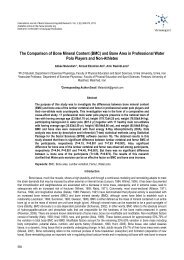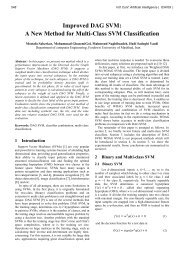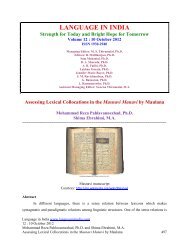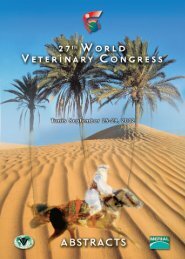Synthesizing UHMWPE Using Ziegler-Natta Catalyst System of ...
Synthesizing UHMWPE Using Ziegler-Natta Catalyst System of ...
Synthesizing UHMWPE Using Ziegler-Natta Catalyst System of ...
Create successful ePaper yourself
Turn your PDF publications into a flip-book with our unique Google optimized e-Paper software.
148<br />
Macromol. Symp. 2008, 274, 148–153 DOI: 10.1002/masy.200851420<br />
<strong>Synthesizing</strong> <strong>UHMWPE</strong> <strong>Using</strong> <strong>Ziegler</strong>-<strong>Natta</strong><br />
<strong>Catalyst</strong> <strong>System</strong> <strong>of</strong> MgCl 2(ethoxide type)/<br />
TiCl 4/tri-isobutylaluminum<br />
Roghieh Jamjah,* 1 Gholam Hossein Zohuri,* 2 Mohsen Javaheri, 1<br />
Mehdi Nekoomanesh, 1 Saeid Ahmadjo, 1 Ali Farhadi 1<br />
Summery: A <strong>Ziegler</strong>-<strong>Natta</strong> catalyst <strong>of</strong> MgCl 2 (ethoxide type)/TiCl 4 has been synthesized.<br />
In order to obtain ultra high molecular weight polyethylene (<strong>UHMWPE</strong>) triisobutylaluminum<br />
which is less active to chain transfer was used as cocatalyst. Slurry<br />
polymerization was carried out for the polymerization <strong>of</strong> ethylene while, dilute<br />
solution viscometry was performed for the viscosity average molecular weight (Mv)<br />
measurement. The effect <strong>of</strong> [Al]/[Ti] molar ratio, temperature, monomer pressure and<br />
polymerization time on the Mv and productivity <strong>of</strong> the catalyst have been investigated.<br />
The results showed increasing [Al]/[Ti] ratio in the range <strong>of</strong> 78–117, decreased<br />
the Mv <strong>of</strong> the obtained polymer from 7.8 10 6 to 3.7 10 6 however, further increase<br />
<strong>of</strong> the ratio, resulted in decreased <strong>of</strong> by much slower rate up to [Al]/[Ti] ¼ 588. The<br />
higher pressure in the range <strong>of</strong> 1–7 bars showed the higher the Mv <strong>of</strong> the polymer<br />
obtained, while increasing temperature in the range <strong>of</strong> 50 to 90 8C decreased the Mv<br />
from 9.3 10 6 to 3.7 10 6 . The Mv rapidly increase with polymerization time in the<br />
first 15 minutes <strong>of</strong> the reaction, this increase was slowly up to the end <strong>of</strong> the reaction<br />
(120 min). Increasing [Al]/[Ti] ratio raised productivity <strong>of</strong> the catalyst in the range<br />
studied. Rising reaction temperature from 50 to 75 8C increased the productivity <strong>of</strong><br />
the catalyst however, further increase in the temperature up to the 90 8C decreased<br />
activity <strong>of</strong> the catalyst. Monomer pressure in the range 1 to 7 bars yields higher<br />
productivity <strong>of</strong> the catalyst. Also by varying polymerization conditions synthesizing<br />
<strong>of</strong> <strong>UHMWPE</strong> with Mv in the range <strong>of</strong> 3 10 6 to 9 10 6 was feasible.<br />
Keywords: dilute solution viscometry; slurry polymerization; <strong>UHMWPE</strong>; <strong>Ziegler</strong>-<strong>Natta</strong><br />
catalyst<br />
Introduction<br />
Many <strong>Ziegler</strong>-<strong>Natta</strong> catalysts are used for<br />
polymerization <strong>of</strong> ethylene leading to high<br />
density polymer (HDPE). A special class <strong>of</strong><br />
HDPE is ultra high molecular weight<br />
polyethylene (<strong>UHMWPE</strong>).The polymer is<br />
high density polyethylene with a molecular<br />
weight over 1 10 6 . Polymerization pro-<br />
1<br />
Iran Polymer and Petrochemical Institute, P.O.Box:<br />
14965/115, Tehran, Iran<br />
E-mail: R.Jamjah@ippi.ac.ir<br />
2<br />
Department <strong>of</strong> Chemistry, Faculty <strong>of</strong> Science,<br />
Ferdowsi University <strong>of</strong> Mashhad, 91775- Mashhad,<br />
I. R. Iran<br />
E-mail: G.Zohuri@ippi.ac.ir<br />
Copyright ß 2008 WILEY-VCH Verlag GmbH & Co. KGaA, Weinheim<br />
cesses for production <strong>of</strong> <strong>UHMWPE</strong><br />
employs is also heterogeneous <strong>Ziegler</strong> -<br />
<strong>Natta</strong> similar to the conventional HDPE. [1–5]<br />
However, polyethylene with molecular<br />
weight as high 1 10 6 was produced using<br />
metallocene catalyst as well. [3,6]<br />
In the polymerization, polymerization<br />
method, reaction conditions such as<br />
temperature, pressure, type <strong>of</strong> catalyst,<br />
cocatalyst, and chain transfer agent can<br />
significantly influence the composition,<br />
molecular weight and its distribution,<br />
degree <strong>of</strong> branching and hence the final<br />
architecture <strong>of</strong> the polymer obtained. [1,2,7,8]<br />
<strong>UHMWPE</strong> has desirable physical and<br />
mechanical character such as high abrasion
Macromol. Symp. 2008, 274, 148–153 149<br />
resistance, high toughness, good corrosion<br />
and chemical resistance, resistance to<br />
radiation, resistance to cyclic fatigue and<br />
extremely high fiber modulus. [1,2,9–11] These<br />
properties are directly connected with the<br />
molecular structure <strong>of</strong> the polymer determined<br />
by polymerization conditions and<br />
catalyst system composition used. [7,8]<br />
Researcher in this direction showed that<br />
<strong>UHMWPE</strong> <strong>of</strong> different morphology can be<br />
synthesized by using highly active supported<br />
catalyst along with a change in<br />
polymerization conditions. [7,12,13] The polymer<br />
display poor processes ability and<br />
products <strong>of</strong> <strong>UHMWPE</strong> possess fusion<br />
defects or grain –boundaries may lead to<br />
poor mechanical performance <strong>of</strong> the finished<br />
polymer particles which cause <strong>UHMWPE</strong><br />
eventually fails in some application. [1,14]<br />
The aim <strong>of</strong> the present work is to study<br />
the effect <strong>of</strong> polymerization conditions on<br />
molecular weight <strong>of</strong> <strong>UHMWPE</strong> produced<br />
using the prepared heterogeneous MgCl2<br />
(ethoxide type)/TiCl4/TiBA catalyst system<br />
in slurry polymerization.<br />
Experimental Part<br />
Tri-isobutylaluminum (TiBA) was acquired<br />
from Schering Co Ltd (Bergkaman,<br />
Germany). Other chemical, catalyst preparation<br />
method, polymerization procedure<br />
is described elsewhere. [15,16] The<br />
viscosity average molecular weight (MV)<br />
<strong>of</strong> the polymer was determined using dilute<br />
solution viscometry according to refs [15–17]<br />
while a silicon oil bath containing three<br />
viscometers was used to obtain constant<br />
temperature required.<br />
Result and Discussion<br />
Several factors could affect on molecular<br />
weight <strong>of</strong> polyethylene using MgCl2 (ethoxide<br />
type)/TiCl4/TiBA catalytic system.<br />
Mg(OC2H5)2 was used as starting chemical<br />
Table 1.<br />
Effect <strong>of</strong> [TiBA]:[Ti] molar ratio on productivity <strong>of</strong> the<br />
catalyst and MV <strong>of</strong> the polyethylene obtained.<br />
[Al]:[Ti] g PE/mmol Ti. MV 10 6<br />
78:1 40 7.8<br />
117:1 714 5.8<br />
157:1 1188 3.7<br />
196:1 1701 3.8<br />
290:1 2591 –<br />
392:1 3598 3.2<br />
486:1 4253 3.1<br />
588:1 4784 3.8<br />
Polymerization conditions; temp ¼ 60 8C, monomer<br />
pressure ¼ 7 bars, time ¼ 2 hours.<br />
Figure 1.<br />
Effect <strong>of</strong> [Al]:[Ti] on productivity <strong>of</strong> the catalyst (–&–) and Mv <strong>of</strong> the polymer obtained (-~-). Polymerization<br />
conditions as in Table 1.<br />
Copyright ß 2008 WILEY-VCH Verlag GmbH & Co. KGaA, Weinheim www.ms-journal.de
150<br />
Macromol. Symp. 2008, 274, 148–153<br />
Figure 2.<br />
Effect <strong>of</strong> temperature reaction on productivity (-~-) and the MV (–&–) <strong>of</strong> the polyethylene. Polymerization<br />
conditions, [Al]:[Ti] ¼ 117:1, monomer pressure ¼ 7 bars, polymerization time ¼ 2h.<br />
which could converted to MgCl2 during the<br />
catalyst preparation. Mg(OC2H5)2 has<br />
advantage which is not hygroscopic comparing<br />
to MgCl2 itself. To obtain high<br />
molecular weight polymer TiBA was used<br />
as cocatalyst which is less active for chain<br />
transfer to occur comparing to common<br />
cocatalyst used for this kind <strong>of</strong> <strong>Ziegler</strong><br />
<strong>Natta</strong> catalyst which is tri-ethylaluminum<br />
(TEA). The effect <strong>of</strong> [Al]:[Ti] molar ratio<br />
on activity and MV was studied using the<br />
catalytic system. [Al]:[Ti] molar <strong>of</strong> 78 to 588<br />
was used at 60 o C and monomer pressure <strong>of</strong><br />
7 bars for 2 hours. The MV decreased with<br />
Figure 3.<br />
Rate/time pr<strong>of</strong>ile <strong>of</strong> the reaction. Polymerization conditions; temp ¼ 40 8C, monomer pressure ¼ 4 bars,<br />
polymerization time ¼ 2h, [Al]:[Ti] ¼ 117:1.<br />
Copyright ß 2008 WILEY-VCH Verlag GmbH & Co. KGaA, Weinheim www.ms-journal.de
Macromol. Symp. 2008, 274, 148–153 151<br />
Figure 4.<br />
Effect <strong>of</strong> polymerization time on the M V. Polymerization conditions; Tem ¼ 60 8C, monomer pressure ¼ 7 bars,<br />
[Al]:[Ti] ¼ 117:1.<br />
Figure 5.<br />
Effect <strong>of</strong> monomer pressure on both activity (-~-) and M V (–&–) <strong>of</strong> the obtained polymer. Polymerization<br />
conditions; [Al]:[TI] ¼ 117:1 temp ¼ 60 8C, time ¼ 2h.<br />
addition <strong>of</strong> TiBA concentration to a limiting<br />
value <strong>of</strong> about 3 10 6 (Table 1).<br />
Productivity <strong>of</strong> the catalyst in term <strong>of</strong> g<br />
PE/mmol Ti was continuously increased<br />
with increasing [Al]:[Ti] molar ratio to<br />
588:1 which was studied. The behavior<br />
indicate <strong>of</strong> less ability <strong>of</strong> TiBA to<br />
deactivate Ti IV and Ti III active centers to<br />
less active sites <strong>of</strong> Ti II (Table 1 and Figure 1).<br />
Optimum activity <strong>of</strong> the catalyst was<br />
obtained at 75 8C while the MV decreased<br />
from 9.3 10 6 to 3.0 10 6 with increasing<br />
Copyright ß 2008 WILEY-VCH Verlag GmbH & Co. KGaA, Weinheim www.ms-journal.de
152<br />
Macromol. Symp. 2008, 274, 148–153<br />
temperature from 50 to 90 8C (Figure 2).The<br />
higher the temperature the more chain<br />
transfer to occur. [18,19]<br />
The MV as high 9.3 10 6 was obtained at<br />
polymerization temperature <strong>of</strong> 50 8C and<br />
monomer pressure <strong>of</strong> 7 bars. The highest <strong>of</strong><br />
the MV obtained in the study.<br />
Rate/time pr<strong>of</strong>ile <strong>of</strong> the catalyst was a<br />
decay type without an induction period<br />
(Figure 3) as reported. [20]<br />
However the M V sharply increased<br />
during early stage <strong>of</strong> the polymerization<br />
(up to 15 min) following to a slow increase<br />
with polymerization time to 2 hours<br />
(Figure 4). [18]<br />
The effect <strong>of</strong> monomer pressure <strong>of</strong> 1 to 7<br />
bars on activity <strong>of</strong> the catalyst and the MV<br />
<strong>of</strong> the polymer were studied. Activity <strong>of</strong> the<br />
catalyst was almost exponentially increased<br />
with monomer pressure. The behavior<br />
could be due to high concentration <strong>of</strong> the<br />
monomer close to active centers and more<br />
fragmentation <strong>of</strong> the catalyst which may<br />
occur at higher monomer pressure<br />
(Figure 5). [16,21,22] The MV <strong>of</strong> the polyethylene<br />
obtained was also increased with<br />
the monomer pressure (Figure 5). The MV<br />
as high 7.8 10 6 was obtained at monomer<br />
pressure <strong>of</strong> 7 bars. The behavior is due to<br />
high concentration <strong>of</strong> monomer in polymerization<br />
media which lead more propagation<br />
to carry out.<br />
Conclusion<br />
Ultra high molecular weight polyethylene<br />
may produce using <strong>Ziegler</strong>-<strong>Natta</strong> catalyst<br />
system <strong>of</strong> MgCl2 (ethoxide type)/TiCl4/<br />
TiBA which contain TiBA as cocatalyst.<br />
The cocatalyst has not high activity as chain<br />
transfer agent. Increasing both <strong>of</strong> TiBA<br />
concentration and polymerization temperature<br />
decreased the M V, while higher<br />
monomer pressure raised the MV. Activity<br />
<strong>of</strong> the catalyst was increased with monomer<br />
pressure and TiBA concentration in the<br />
range studied. In the whole range <strong>of</strong> this<br />
study the MV <strong>of</strong> higher than 3 10 6 was<br />
obtained. The highest <strong>of</strong> the MV was<br />
obtained at 50 8C and monomer pressure<br />
<strong>of</strong> 7 bars. From the study can say that<br />
temperature is more affected on the MV <strong>of</strong><br />
the polymer obtained than monomer pressure<br />
and also TiBA concentration. Rate/<br />
time pr<strong>of</strong>ile <strong>of</strong> the polymerization was a<br />
decay type. No optimum value <strong>of</strong> [TiBA]:<br />
[Ti] ratio was observed base on activity <strong>of</strong><br />
the catalyst in the range studied.<br />
It is shown that by careful selection <strong>of</strong><br />
catalyst concentration and mole ratio <strong>of</strong> the<br />
catalyst components in slurry polymerization,<br />
<strong>UHMWPE</strong> with molecular weights<br />
from 3 10 6 to 9.3 10 6 can be obtained.<br />
[1] H. F. Mark, N. M. Bikales, C. G. Overberger, Q.<br />
Menges, ‘‘Encyclopedia <strong>of</strong> Polymer Science and Engineering’’,<br />
Vol. 6, 2 nd Edn. Wiley Interscience, 1997, 384–<br />
386, 454–466, and 490–492.<br />
[2] A. J. Peacock, ‘‘Handbook <strong>of</strong> Polyethylene’’, Marcel<br />
Dekker, INC, New York 2000.<br />
[3] G. K. Sharma, Easily Processable Ultra High Molecular<br />
Weight Polyethylene with Narrow Molecular<br />
Weight Distribution, PhD thesis submitted to Technische<br />
Universities Eindhoven 2005.<br />
[4] J. Spavecek, Polymer 1978, 19, 1149.<br />
[5] J. C. Dasilva, C. M. O. De Figueiredo, US Past<br />
6,384,163 B1, 2002.<br />
[6] J. C. Liu, M. P. Make, C. C. Lee, US Pat 6,265,504, B1,<br />
(2001).<br />
[7] M. Velikova, Eur. Polym. J. 2001, 37, 1255.<br />
[8] Q. R. Zhu, K. L. Hong, L. Q. Ji, R. R. Qi, G. E. Zhou,<br />
M. S. Song, Y. W. Wong, J. Polym. Sci. Part B, Polym.<br />
Phys. Ed. 1995, 33, 739.<br />
[9] C. F. Xiao, Y. F. Zhang, S. L. An, G. X. Jia, Polym. Eng.<br />
Sci. 2000, 40(1), 238.<br />
[10] P. J. Lemstra, H. C. Booij, J. Polym. Sci. Polym. Phys.<br />
Ed. 1981, 19, 877.<br />
[11] C. F. Xiao, Y. F. Zhang, S. L. An, G. X. Jia, J. Appl.<br />
Polym. Sci. 1996, 59, 931.<br />
[12] L. Minkova, M. Velikova, D. Damyanov, Eur.<br />
Polym. J. 1988, 24, 661.<br />
[13] M. Velikova, L. Minkova, D. Damyanov, S.<br />
Rangelov, Eur. Polym. J. 1997, 33, 403.<br />
[14] A. Keller, M. Hikosaka, A. Toda, S. Rastogi, P. J.<br />
Barham, G. J. Goold beckwood, J. Mater. Sci. 1994, 29,<br />
2579.<br />
[15] G. H. Zohuri, S. Ahmadjo, R. Jamjah, M.<br />
Nekoomanash, Iranian Polymer Journal 2001, 10(3),<br />
149.<br />
[16] G. H. Zohuri, R. Jamjah, R. Mehtarani, M. Nekoomanesh,<br />
S. Ahmadjo, Iranian Polym Journal 2003, 12(1),<br />
31.<br />
[17] J. Brandrup, E. H. Immergut, ‘‘Polymer Handbook’’,<br />
3 rd ed. John Wiley & Sons, New York 1989, VII, 1–7.<br />
Copyright ß 2008 WILEY-VCH Verlag GmbH & Co. KGaA, Weinheim www.ms-journal.de
Macromol. Symp. 2008, 274, 148–153 153<br />
[18] P. J. T. Tait, ‘‘Comprehensive Polymer Science’’, Vol.<br />
4, Pergamon press, 1989, Ch. 2, 549–555.<br />
[19] T. Keii, ‘‘Kinetics <strong>of</strong> <strong>Ziegler</strong>-<strong>Natta</strong> Polymerization’’,<br />
Kodansha, Tokyo 1972.<br />
[20] P. J. T. Tait, G. H. Zohuri, A. M. Kells, Maeromol.<br />
Symp. 1995, 89, 125.<br />
[21] Y. V. Kissin, S. M. Mezhikovsky, N. M. Chirkov, Eur.<br />
Polym. J. 1970, 6, 267.<br />
[22] P. J. T. Tait, G. H. Zohuri, A. M. Kells, I. D. Mckenzie,<br />
‘‘<strong>Ziegler</strong>-<strong>Natta</strong> <strong>Catalyst</strong>s’’, Fink, Mulhaupt, Brintzinger,<br />
Eds., Springer-Verlag, Berlin Heidelberg 1995, 343–<br />
361.<br />
Copyright ß 2008 WILEY-VCH Verlag GmbH & Co. KGaA, Weinheim www.ms-journal.de








